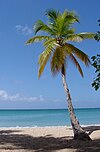bio.wikisort.org - Plant
Washingtonia is a genus of palms, native to the southwestern United States (in southern California, and southwest Arizona) and northwest Mexico (in Baja California and Sonora).[2] [3] Both Washingtonia species are commonly cultivated across the Southern United States, the Middle East, southern Europe, and North Africa, where they have greatly hybridized.
| Washingtonia | |
|---|---|
 | |
| Scientific classification | |
| Kingdom: | Plantae |
| Clade: | Tracheophytes |
| Clade: | Angiosperms |
| Clade: | Monocots |
| Clade: | Commelinids |
| Order: | Arecales |
| Family: | Arecaceae |
| Subfamily: | Coryphoideae |
| Tribe: | Trachycarpeae |
| Genus: | Washingtonia H. Wendl. 1879,[1] conserved name not Winslow 1854 (syn of Sequoiadendron) |
| Species | |
| |
| Synonyms[2] | |
|
Neowashingtonia Sudw. | |
Description
They are fan palms (subfamily Coryphoideae), with the leaves with a bare petiole terminating in a rounded fan of numerous leaflets. The flowers are in a dense inflorescence, with the fruits maturing into a small blackish-brown drupe 6–10 mm diameter with a thin layer of sweet flesh over the single seed.[4]
Extant species
There are three species: Washingtonia robusta, Washingtonia filifera, and Washingtonia filibusta
The fruit is edible, and was used by Native American people as a minor food source. They are also eaten by birds, which disperse the seeds in their droppings after digesting the fruit pulp. Washingtonia species are also used as food plants by the larvae of some Lepidoptera species, including Paysandisia archon.
Both species are cultivated as ornamental trees, widely planted in California, Florida, Texas, extreme southwest Utah, Arizona, southern New Mexico, South Carolina, and southern areas of North Carolina. It is also cultivated in the Mediterranean region in southern Europe and north Africa, parts of Australia, and the leeward sides of the Hawaiian Islands. W. filifera is modestly hardy in drier climate and able to survive brief temperatures in the vicinity of -15 °C (10 °F), provided the air and soil are not too wet, and the afternoon temperatures are not too cold. Intolerance of wet, prolonged cold is the main reason the filifera species cannot grow in temperate climates. W. robusta is less sensitive to moisture than filifera, but far more easily damaged by cold.
The genus is named after George Washington.[5]
Image gallery
- Washingtonia filifera
- Washingtonia robusta
- Washingtonia palms near Twentynine Palms, California, USA
- Washingtonia palms in New Borg El Arab, Egypt.
- Washingtonia fronds
- Historic fan palm (first known transplanting late 1850s[6]) in Exposition Park, Los Angeles, California, USA
- Washingtonia filifera, inflorescence and the fruiting season
References
- H.A. Wendland, Botanische Zeitung 37:1xi, 68, 148. 1879 (conserved name)
- Kew World Checklist of Selected Plant Families
- Jon P. Rebman, Judy Gibson, and Karen Rich. Annotated checklist of the vascular plants of Baja California, Mexico. 2016. Proceedings of the San Diego Society of Natural History. number 45. page 275.
- Riffle, Robert L. and Craft, Paul (2003) An Encyclopedia of Cultivated Palms. Portland: Timber Press. ISBN 0-88192-558-6 / ISBN 978-0-88192-558-6
- German botanist Hermann Von Wendland designated the name in 1879. http://www.public.asu.edu/~camartin/plants/Plant%20html%20files/washingtonia_filifera.htm
- D.J. Waldie (10 May 2013). "Remembering What's Always Been Here: The Oldest Palm". www.kcet.org/. Retrieved 2019-03-02.
External links
- Flickr: Washingtonias in Russian National Subtropical Garden
- Flora of North America: Washingtonia
- Scanpalm: Washingtonia
- Washingtonia filifera: Native habitats in Arizona - reprinted from Principes, 34,(4), 1990, pp. 177-180
На других языках
- [en] Washingtonia
[es] Washingtonia
Washingtonia es un género con seis especies de plantas con flores perteneciente a la familia de las palmeras Arecaceae.[3][ru] Вашингтония
Вашингто́ния (лат. Washingtonia) — род древесных растений семейства Пальмовые (лат. Arecaceae, или Palmae) с юго-запада США и северо-запада Мексики.Другой контент может иметь иную лицензию. Перед использованием материалов сайта WikiSort.org внимательно изучите правила лицензирования конкретных элементов наполнения сайта.
WikiSort.org - проект по пересортировке и дополнению контента Википедии








![Historic fan palm (first known transplanting late 1850s[6]) in Exposition Park, Los Angeles, California, USA](http://upload.wikimedia.org/wikipedia/commons/thumb/e/eb/Palm_tree_expo_park_coliseum_peristyle.jpg/87px-Palm_tree_expo_park_coliseum_peristyle.jpg)

